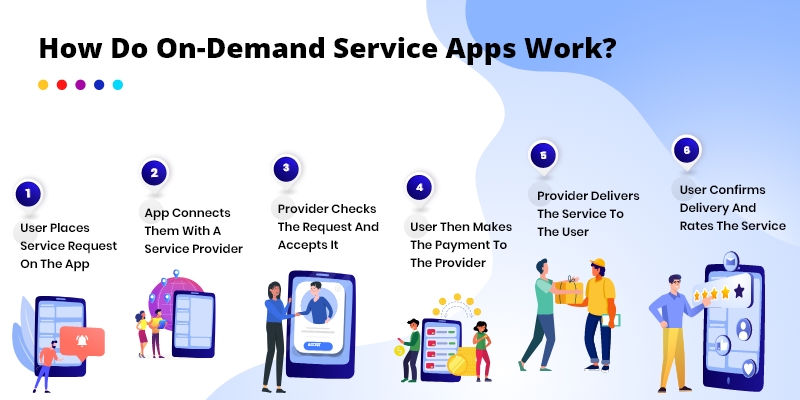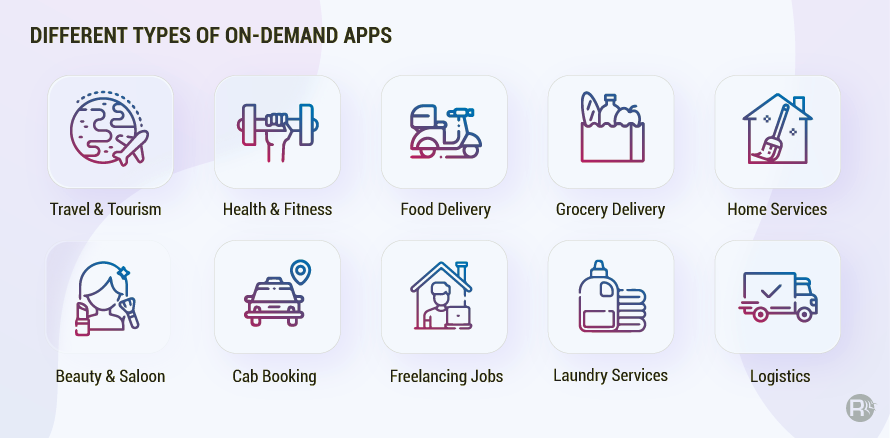In today’s fast-paced world, people seek quick and efficient services. On-demand apps have emerged as a popular solution for providing services such as food delivery, taxi booking, house cleaning, and much more. Developing an on-demand app requires a strategic approach that balances business needs, customer requirements, and technological capabilities.
How Do On-Demand Services Apps Works?
On-demand service apps work by connecting users who need a service with service providers who can provide the service. Here are the basic steps involved in how on-demand service apps work:
- Registration: Users and service providers register on the app by providing their basic information such as name, email, phone number, and payment information.
- Service selection: Users select the service they need from the list of services offered on the app. This can range from transportation, food delivery, home cleaning, laundry, to dog walking, etc.
- Service request: Once the user selects the service, they can request the service and provide details such as location, time, and date of service.
- Matching: The app matches the user’s request with the nearest available service provider who can fulfill the request.
- Confirmation: Once a service provider accepts the request, the user receives a confirmation with details of the service provider, their location, and estimated time of arrival.
- Service delivery: The service provider arrives at the user’s location and provides the requested service.
- Payment: The payment for the service is made through the app using the payment information provided during registration.
- Rating and feedback: After the service is complete, the user can rate the service provider and provide feedback, which helps the app improve its service quality.
Overall, on-demand service apps work by providing a platform that connects users and service providers in a seamless and convenient manner, making it easy to access services quickly and efficiently.

This blog will discuss an expert approach to building an on-demand app.
The Future of Business: Building an On-Demand App

- Market Research
- Before developing an on-demand app, it is essential to conduct market research to understand customer needs, competitor offerings, and market trends. The research should focus on identifying gaps in the market that your app can fill. This information will help you define your business model and identify unique features that can differentiate your app from others.
- User Experience
- The success of an on-demand app depends on its user experience. Users should be able to navigate the app easily, make requests quickly, and receive services promptly. The design and functionality of the app should be intuitive and responsive. To ensure a positive user experience, app developers should engage with users throughout development to receive feedback and make improvements.
- Technology Stack
- An on-demand app requires a robust and scalable technology stack. The technology stack should be flexible to accommodate changes and updates as the app evolves. The app should be built on a secure and reliable platform to ensure the safety of user data. App developers should also consider using cloud computing services for scalability and cost-effectiveness.
- Agile Development
- Agile development is a methodology that involves iterative and incremental development. It is a flexible approach that allows changes to be made quickly based on user feedback. Agile development helps app developers prioritize features and functionality critical to the app’s success.
- Payment Gateway Integration
- An on-demand app should provide users multiple payment options, such as credit/debit cards, online wallets, and net banking. The app should integrate with a secure and reliable payment gateway to ensure the safety of user transactions. Payment gateway integration should be seamless and easy to use to encourage users to make payments through the app.
- Real-time Tracking
- Real-time tracking is an essential feature of an on-demand app. Users should be able to track their orders in real time and receive updates on the status of their requests. Real-time tracking improves user satisfaction and reduces the number of support requests. App developers should ensure that the tracking system is accurate and reliable.
- Push Notifications
- Push notifications are a powerful tool for engaging users and informing them about updates and promotions. App developers should use push notifications to provide users with relevant information such as order status, discounts, and offers. Push notifications should be personalized, timely, and not intrusive.
- Quality Assurance
- Quality assurance is a critical aspect of app development. App developers should conduct rigorous testing to ensure the app is free of bugs, glitches, and crashes. Quality assurance should be an ongoing process throughout the development cycle, and app developers should use testing tools to automate the process.
- Launch Strategy
- Launching an on-demand app requires a well-defined strategy that includes marketing, user acquisition, and retention. App developers should create a buzz around the launch using social media, email marketing, and influencer outreach. The app should be launched in phases to ensure the initial load is manageable and user feedback can be incorporated quickly.
- Monetization
- An on-demand app can be monetized through various methods, such as commission-based models, subscription-based models, and in-app advertising. App developers should choose a monetization strategy that aligns with their business goals and does not compromise the user experience.
- Security Features
- An on-demand app should prioritize the security of user data. App developers should implement
- robust security features such as SSL encryption, two-factor authentication, and data encryption to protect user information from hackers and other cyber threats. App developers should also regularly update the app to address any security vulnerabilities.
- Analytics and Metrics
- App developers should track and analyze user behaviour to improve the app’s performance and user experience. Analytics and metrics can provide insights into user engagement, retention, and satisfaction. App developers can use analytics tools to identify trends and patterns and make data-driven decisions to improve the app.
- User Acquisition
- User acquisition is a critical aspect of app development. App developers should create a targeted marketing strategy focusing on reaching potential users through social media, search engine optimization, and paid to advertise. User acquisition should be an ongoing process, and app developers should continuously monitor and optimize their marketing efforts to maximize user acquisition.
- Retention Strategies
- Retaining users is just as important as acquiring them. App developers should implement retention strategies to keep users engaged with the app. Retention strategies can include loyalty programs, personalized recommendations, and in-app promotions. App developers should also focus on improving the app’s user experience to encourage users to continue using the app.
Conclusion
In conclusion, building an on-demand app requires a strategic approach considering business needs, customer requirements, and technological capabilities. App developers should conduct market research, prioritize user experience, use a robust technology stack, adopt agile development, integrate a secure payment gateway, including real-time tracking and push notifications, prioritize quality assurance, implement a launch strategy, choose a monetization strategy, prioritize security features, track analytics and metrics, focus on user acquisition, and implement retention strategies. By following these expert approaches, app developers can build a successful on-demand app that meets the needs of their target audience.
